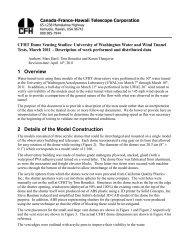ALLEN BRADLEY 1747-L551 PLC Processor
ALLEN BRADLEY 1747-L551 PLC Processor
ALLEN BRADLEY 1747-L551 PLC Processor
You also want an ePaper? Increase the reach of your titles
YUMPU automatically turns print PDFs into web optimized ePapers that Google loves.
3–8<br />
System Installation Recommendations<br />
Emergency-Stop Switches<br />
Adhere to the following points concerning emergency-stop switches:<br />
• Do not program emergency-stop switches in the controller<br />
program. Any emergency-stop switch should turn off all machine<br />
power by turning off the master control relay.<br />
• Observe all applicable local codes concerning the placement and<br />
labeling of emergency-stop switches.<br />
• Install emergency-stop switches and the master control relay in<br />
your system. Make certain that relay contacts have a sufficient<br />
rating for your application. Emergency-stop switches must be<br />
easy to reach. See the following schematics.<br />
Power Considerations<br />
The following explains power considerations for the SLC 500<br />
processor.<br />
Common Power Source<br />
We strongly recommend that all chassis power supplies have the<br />
same power source as the input and output devices. This helps<br />
reduce the chance of electrical interference due to multiple sources<br />
and grounds as well as helps maintain system integrity if power is<br />
interrupted.<br />
The processor detects the absence of power to any chassis in the<br />
system. If power to any chassis is lost (or not yet applied), the CPU<br />
FAULT LED turns on and all controller outputs are de-energized.<br />
This fault detection makes it necessary that you apply power to the<br />
expansion chassis before you apply power to the chassis containing<br />
the processor to avoid an unwanted fault. Of course, applying power<br />
in sequence is unnecessary if all chassis have a common power<br />
source.<br />
Isolation Transformer<br />
In many industrial applications, a step-down transformer is required<br />
to reduce line voltage to 120 or 240V ac. This transformer also<br />
provides isolation to protect equipment from high voltage transients<br />
that may be generated on your power distribution system.<br />
Publication <strong>1747</strong>-6.2




![Documentation [PDF] - Canada France Hawaii Telescope ...](https://img.yumpu.com/26965302/1/190x245/documentation-pdf-canada-france-hawaii-telescope-.jpg?quality=85)







